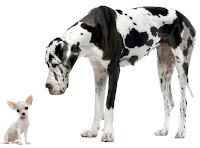Crafting Collaboration with Stigmergy
 It's been a while since I bumped into a PhD thesis on mass collaboration. The Wikinomics blog pointed to it. The thesis was written by Mark Elliott and is titled "Stigmergic Collaboration. A theoretical Framework for Mass Collaborationn". Pretty interesting title, I thought, and I hoped more people would read and discuss it. But I haven't seen much talk about Elliott's work yet.
It's been a while since I bumped into a PhD thesis on mass collaboration. The Wikinomics blog pointed to it. The thesis was written by Mark Elliott and is titled "Stigmergic Collaboration. A theoretical Framework for Mass Collaborationn". Pretty interesting title, I thought, and I hoped more people would read and discuss it. But I haven't seen much talk about Elliott's work yet. Anyway I promised to write about this book and I hope my post will get people to at least read this nice piece of work.
Well, there's a lot from Elliott's work that I would like to pass on. I'll mainly write on what I learned (and I'm not even sure if I really grasp all of it). You can find a summary of the book on Mark's site, so I won't make another one (for you).
The concept 'stigmergy' was new to me, even though I like to read about complex, living systems and concepts like 'coevolution', 'edge of chaos', etc.
So what is 'stigmergy'? It's "indirect communication between agents which is coordinated through interactions with their local environment" (p. 7). Or: "Stigmergy is a class of behaviour in which collective activity is coordinated through the individuals' response to and modification of their local environment - one's agent's modification becomes another's cue". (p. 8)
After reading this I bet you think: Hey, this sounds like blogs, wiki's and Twitter. Well, that's exactly what Elliott focuses on: the intersection of stigmergy and collaboration, because it "provides an entirely new way of conceptualising collaboration and thus the emergence of mass collaboration which represents the most well developed and extended collective creative process currently available to humanity." Stigmergy does not only give a theoretical framework explaining the effects of mass collaboration, but also "the root dynamics of this activity, providing an explanation for the coordination between the collaborating/cooperating 'produser' and their media of choice". (p. 9, also p. 205) At the end of Elliot's work 'stigmeric mechanisms' are even stated to be "virtually identical to the mechanisms used by the human brain." (p. 214)
Elliotts work is about providing an adequate definition or criteria for discerning collaboration from other collective activities such as cooperation and coordination. He says Tapscott and Williams failed to give this definition in their book 'Wikinomics'.
So how does Mark define collaboration?
Collaboration is the process of two or more people collectively creating emergent, shared representations of a process and or outcome that reflects the input of the total body of contributors. (204)
And this is how collaboration, coordination and cooperation are related:
[T]here is an interrelated and important relationship between the three with coordination providing the necessary conditions for cooperation as cooperation does for collaboration. (204)
Elliott goes on "to discriminate between discursive collaboration—the collaborative generation of pure ideas through discussion, and stigmergic collaboration—the externalisation of such ideas through various forms of collective material production." (204)
Stigmergic collaboration can be achieved in digital networks to enable collective creativity. How this can be done, is also described. This is an interesting part of his work that I did not completely understand and have to look into more closely. Anyway, what is clear, is that it closely relates to getting coordination and cooperation right:
Stigmergic collaboration can be achieved in digital networks to enable collective creativity. How this can be done, is also described. This is an interesting part of his work that I did not completely understand and have to look into more closely. Anyway, what is clear, is that it closely relates to getting coordination and cooperation right:
Digital stigmergic collaboration is introduced, showing how digital stigmergic coordination and cooperation form its enabling conditions and providing the capacity for collaborative output to become a shared digital artefact which may span the Internet’s world-wide network, providing simultaneous co-locality to a locus of creative engagement to a near infinite numbers of collaborative participants. Overall, stigmergy is found to play a central role in not only the structure, nature and ongoing expansion of the Internet, ranging from the coordination of its most basic navigational features to the emergence of cutting-edge practices increasingly referred to as ‘Web 2.0’, but in the evolution of humanity’s collective creative abilities. (205)
Well, this was in short what I learned and I'm pretty sure I didn't get all of it. For that reason it would nice if Mark could write several (short) posts explaining his work and its implications.



Hi Samuel, thanks for the great post on my phd!
ReplyDeleteI'm very interested in the sections you'd like to see further discussed. As you may have seen, over the next month or so I'll be posting to my blog as I get each chapter migrated to my new website. I'm interested to know more about what topics would be worth further discussion as I do this. - Writing a phd for examiners can have a tendency to push one towards highly technical description :-).
It's great to see folks out there finding it useful and interesting!
Cheers,
mark
Good to hear from you, Mark! What I'm studying in more detail, as I wrote, is the part on how to make collaboration stigmeric (if that's the way to put it...). It would be very nice if you could explain that in small steps with some examples from practice. Look forward to read your posts on your PhD!
ReplyDelete